Richard III: The mystery of the king and the car parking lot
February 1, 2013 -- Updated 1847 GMT (0247 HKT)
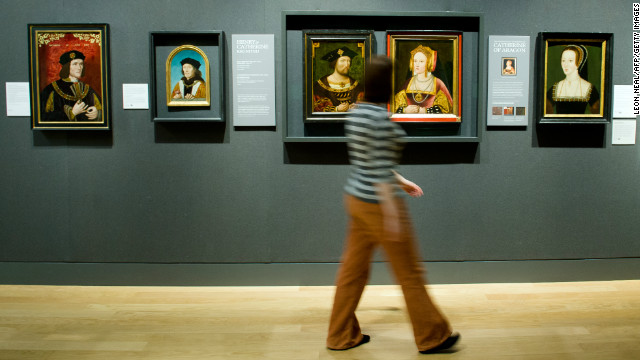
Richard III, far left, at the National Portrait Gallery in London, is one of the most notorious figures in British history
STORY HIGHLIGHTS
- Richard III was portrayed by Shakespeare as a hunchbacked villain
- But experts point out much of what we "know" about him was written under his successor
- Remains found in a parking lot in Leicester, England, are being DNA tested to see if they are his
- Archaeologists believe that if the skeleton is his, history may have to be rewritten
"He's been waiting
hundreds of years," says one woman, gesturing towards the archway up
ahead with a smile. "It won't kill us to hang on for half an hour."
"He" is Richard III, one
of the most famous kings of England, remembered by school children and
Shakespeare aficionados alike as a notorious villain, hunchbacked and
hateful, accused of killing his own nephews, the "Princes in the Tower,"
to usurp the throne, and whose whereabouts were, until recently, a
complete mystery.
The history books record
that in August 1485, Richard - the last English king to die in battle -
rode out from Leicester, in central England, to the Battle of Bosworth Field. There he met his end; his body was returned to the city days later, ignominiously lashed to a packhorse.
While other monarchs
might have been granted all the pomp and ceremony of a state funeral, as
a defeated warrior, Richard was accorded no such regal treatment.
Instead his naked remains were put on display to prove to supporters and
opponents alike that he really was dead, before being hastily buried in
a nearby church.
Which is why, more than
520 years on, a crowd has gathered in this municipal car park, though
there's little to explain their excitement - at first glance, the most
remarkable thing seems to be the lack of vehicles in the worn white
parking bays.
Overlooked by the spire
of the nearby cathedral, fluorescent overall-clad archaeologists and
historians gather near a hole in the ground. It looks like any other set
of roadworks, the surface scraped back to reveal layers of earth.
Remains
matching the description of Richard III were found buried beneath a
parking lot in the English city of Leicester last year
But at the far end of the
trench, a laminated copy of a priceless portrait offers a hint as to
why so many people have chosen to spend their Saturday morning in a
parking lot: Experts believe this uninspiring gray square of tarmac was
once part of the Greyfriars Friary -- and might, therefore, be the last
resting place of Richard III.
Who was Richard III?
Richard III was the last Plantagenet king of England, and the last English king to die in battle.
Born on October 2, 1452, he grew up during the bitter and bloody Wars of the Roses, which pitted two aristocratic dynasties, the House of York and the House of Lancaster, against each other in a fight for the throne.
The wars, which took their name from the families' symbols, a red rose for Lancaster and a white rose for York, were fought between 1455 and 1485.
While Richard was still a child, they led to the deaths of his father, the Duke of York, and his brother Edmund, and forced him into exile.
As the youngest son, Richard was never expected to become king, and instead spent many years as a nobleman, apparently intent on founding his own dynasty. His brother Edward became king in 1461, and Richard proved a loyal supporter.
"Shakespeare paints a picture of Richard as a scheming, plotting villain always aiming for the throne, but if that was the case, why didn't he kill the king?" says historian John Ashdown Hill, author of "The Last Days of Richard III."
"That would have been the easiest way, but he served his brother loyally for over 20 years."
When Edward IV died unexpectedly in 1483, he was succeeded by his 12-year-old son, Edward V, with Richard as his protector.
Within weeks, however, parliament had declared the boy illegitimate, and installed Richard as king in his place.
Edward and his brother were held in the Tower of London, and later disappeared. Richard has long been blamed for their murder.
Richard III was the last Plantagenet king of England, and the last English king to die in battle.
Born on October 2, 1452, he grew up during the bitter and bloody Wars of the Roses, which pitted two aristocratic dynasties, the House of York and the House of Lancaster, against each other in a fight for the throne.
The wars, which took their name from the families' symbols, a red rose for Lancaster and a white rose for York, were fought between 1455 and 1485.
While Richard was still a child, they led to the deaths of his father, the Duke of York, and his brother Edmund, and forced him into exile.
As the youngest son, Richard was never expected to become king, and instead spent many years as a nobleman, apparently intent on founding his own dynasty. His brother Edward became king in 1461, and Richard proved a loyal supporter.
"Shakespeare paints a picture of Richard as a scheming, plotting villain always aiming for the throne, but if that was the case, why didn't he kill the king?" says historian John Ashdown Hill, author of "The Last Days of Richard III."
"That would have been the easiest way, but he served his brother loyally for over 20 years."
When Edward IV died unexpectedly in 1483, he was succeeded by his 12-year-old son, Edward V, with Richard as his protector.
Within weeks, however, parliament had declared the boy illegitimate, and installed Richard as king in his place.
Edward and his brother were held in the Tower of London, and later disappeared. Richard has long been blamed for their murder.
Some of them weren't so
sure at first, however. "It seemed like such a harebrained scheme,"
Richard Buckley, the lead archaeologist on the project, tells CNN. "We
didn't expect to find anything."
Applying for permission
to dig at the site, and potentially exhume a body, or bodies, Buckley
says he wrote: "In the unlikely event that we find the remains of
Richard III..."
Nonetheless, at the tail
end of last summer, a team of experts dug three trenches across the
site and began hunting for evidence of the long-lost friary, where
Richard III was recorded to have been buried.
The search turned up
traces of the building, and then something altogether more exciting: A
human skeleton, complete with evidence of battle wounds -- a blow to the
head, and an arrow in the back -- and scoliosis, or curvature of the
spine.
"I didn't think it was
likely to be him at first," explains bioarchaeologist Jo Appleby, who
excavated the remains. "The skull didn't seem to be in quite the right
place -- now we know that's because of the scoliosis -- but it didn't
seem to 'go' with the legs.
"When I lifted the skull
and saw the injury, a little alarm bell started to ring, but I told
myself perhaps someone had dug into the grave at a later date and hit it
with a spade, so I thought 'Don't say anything yet.'
"I cleared the arms and
legs, and then went up the spine, hunting for vertebrae, [but] they
weren't there, they weren't where I expected them to be. Instead they
went in completely the wrong direction. At that point, I thought 'Hang
on!'"
"Someone came over and
said 'I think you need to see this,'" Buckley says. "We were looking at
something else, so I said 'I'm a bit busy at the moment,' and they said
'No, no, you really need to see this.'"
They were stunned to
discover the remains were in surprisingly good condition - particularly
given the fact they were apparently laid to rest in a simple shroud,
with no coffin to protect them.
"There have been so many
changes to the site over the years that the chances of finding the
remains were so slim," says local historian David Baldwin. "It wouldn't
have been at all surprising had they been destroyed."
As a shiver of anticipation spread across the site, one figure sat, deathly pale and shaking, at the side of the trench.
Philippa Langley had
spent years trying to convince archaeologists and authorities alike to
allow the dig for Richard III to go ahead. Now she watched, in shock, as
the search she had championed for so long reached its climax.
"It's been a real labor
of love," she told CNN. "Three years of hard work and tough graft, of
people saying we'd never find him, but it looks like it may have paid
off."
Langley, a screenwriter,
became intrigued by Richard III after reading a book about him on
holiday, and quickly decided he would make a perfect subject for a film.
"His story absolutely
blew me away," she says. "I asked myself 'Why has nobody written this?
Why has nobody told this guy's story?' Robin Hood has had his moment in
the cinema, now it's time for Richard III to have his time on the big
screen too.
Richard III has been played by a host of stars, including Laurence Olivier, here being painted by Salvador Dali
"I decided I needed to
do some research -- I needed to know who he was, what he was about, I
needed to get inside his head, talk his talk, walk his walk, so I went
to Leicester and to Bosworth, but I felt there was no fitting conclusion to the story."
Richard III: Hero or villain?
The Richard III familiar to theatergoers from Shakespeare's play is a born-and-bred bad guy, a child-killing hunchback whose physical deformities echo his deeply nasty nature.
"Deformed, unfinished, sent before my time
Into this breathing world scarce half made up,
And that so lamely and unfashionable
That dogs bark at me as I halt by them..."
"Since I cannot prove a lover," Shakespeare had had him announce, "I am determined to prove a villain."
But modern historians have been at pains to point out that the source material for Shakespeare's and others' portraits of him dates from the reign of his conqueror, Henry VII, and was therefore written with an agenda.
"Richard III was very much a man of his time," says David Baldwin, author of "Richard III". "He was no better or worse than any other nobleman of the era -- if you were offered lands, a fortune, titles, you took them.
"In his case, I think a lot of what happened later in his life can be traced back to his dislocated childhood. His father, his brother had been killed, he was hidden away, driven into exile by the age of nine.
"He was determined to strike first, and that's not surprising given his history."
The Richard III familiar to theatergoers from Shakespeare's play is a born-and-bred bad guy, a child-killing hunchback whose physical deformities echo his deeply nasty nature.
"Deformed, unfinished, sent before my time
Into this breathing world scarce half made up,
And that so lamely and unfashionable
That dogs bark at me as I halt by them..."
"Since I cannot prove a lover," Shakespeare had had him announce, "I am determined to prove a villain."
But modern historians have been at pains to point out that the source material for Shakespeare's and others' portraits of him dates from the reign of his conqueror, Henry VII, and was therefore written with an agenda.
"Richard III was very much a man of his time," says David Baldwin, author of "Richard III". "He was no better or worse than any other nobleman of the era -- if you were offered lands, a fortune, titles, you took them.
"In his case, I think a lot of what happened later in his life can be traced back to his dislocated childhood. His father, his brother had been killed, he was hidden away, driven into exile by the age of nine.
"He was determined to strike first, and that's not surprising given his history."
So she decided to help
create one, by forcing historians to look again at his story, to find
"the real man, and not the myth," because, she believes: "With the
truth, he'll finally be able to rest in peace."
Langley hopes the
physical evidence found so far will be enough to make people rethink
their image of Richard III as a caricature villain.
"It disproves the Tudor
writers who claimed terrible things about him: That he was hunchbacked,
that he was two years in the womb, that he was born with hair and
teeth," she says.
"Instead we can see that
he was a strong, capable man, and it blows all those misconceptions
away. It gives us so much information about Richard, the real Richard,
before the Tudor writers got to him.
"I'm not looking for a
saint, but a real man -- if I've got to portray him on a big screen I
want to show the real him. He wasn't always great and good, but that's
fine, if he was, we'd all be bored to death."
She has even been in talks with Leicestershire lad turned Hollywood hero Richard Armitage -- last seen as Thorin Oakenshield in "The Hobbit" -- to play the king.
"He was born to play the
role," she explains. "He's an amazing doppelganger for Richard III, he
was born a couple of miles from Bosworth on the anniversary of Richard's
death, and he was even named after him."
The film won't be the first attempt to rehabilitate Richard III in the eyes of the general public - mystery writer Josephine Tey tried it in the 1950s with "The Daughter of Time," in which her detective hero "discovers" the truth about the much-maligned monarch.
It was this book which
first sparked the curiosity of Michael Ibsen, prompting him to rethink
the image he had grown up with, of Richard III as "this evil figure who
killed the Princes in the Tower."
Now the Canadian-born
cabinetmaker finds himself at the heart of the story, with a role he
could never have imagined when he read Tey's novel 20 years ago: The
potential DNA match for a long-dead king of England.
"Of course, I'd rather
be related to a benign king figure than a brutal murderer, so it's hard
not to be biased, but some of the history is so vitriolic, I'm a little
suspicious -- can he really have been that bad?"
Historian John Ashdown Hill, author of "The Last Days of Richard III," tracked down Ibsen's British-born mother Joy in 2004.
"She knew she had an
illustrious family background - they were from the upper class, but had
fallen on hard times -- but she had no idea that this was in her past,"
Ibsen says.
Ashdown Hill explained
that as a direct - if long-distant -- female relative of Richard III's
sister, Anne of York, she and her children should have the same
mitochondrial DNA (mtDNA) as Richard III.
Michael Ibsen, a Canadian-born cabinetmaker, is a potential DNA match for Richard III
Joy was skeptical at
first, and in any case, as Ibsen points out "it seemed fairly academic
at the time, we didn't get too excited."
Sadly, Ibsen's mother
died before the Leicester dig could take place, but he was there in her
place as work began, offering up that all important DNA sample.
"My brother and sister
and I all inherited the same mtDNA, but my sister is the only one who
can pass it on, and she has no children, so they caught us just in
time," he told CNN, reflecting on the "surreal experience" of the past
few months.
That DNA now has "the potential to change history," according to Lin Foxhall, professor of archaeology at the University of Leicester.
"It depends how much DNA
we are able to extract," says Turi King, the scientist carrying out
those all-important tests. "The more we get, the more specific we can
be."
"If enough DNA is
collected, we might even be able to tell hair color, eye color," says
Foxhall, adding that this, together with facial reconstruction would be
an "interesting test. since we have portraits of Richard III, but like
written histories, they too can be biased and polemical."
If the remains are proven to be those of Richard III, he may be reburied in the city's cathedral
Ashdown Hill, who has
spent more than 10 years investigating the story of Richard III, is at
pains to point out that the key piece of evidence he helped track down
may not be the be-all and end-all of the story.
"DNA is important, but
it's not the only thing, and even if it does match, there will always be
some people who say 'It's not him,'" he says. "There's no label on the
bones, and there's no-one alive who can say 'I knew him, that's him.'"
"It's always going to be
a leap of faith. All we can do is stack up as much evidence as we can,
so that leap is as small as possible, but in the end, there has to be an
element of belief."
Yet for him, the question was answered in a "very strange moment" at the end of that long day last August.
"A white van was brought
into the car park to take the remains away, and I was asked to carry
the box to the van," he says. "I had all sorts of thoughts going through
my head: This was Richard III, I had been looking for him for so long,
and there I was, as close to him as it is possible to be."

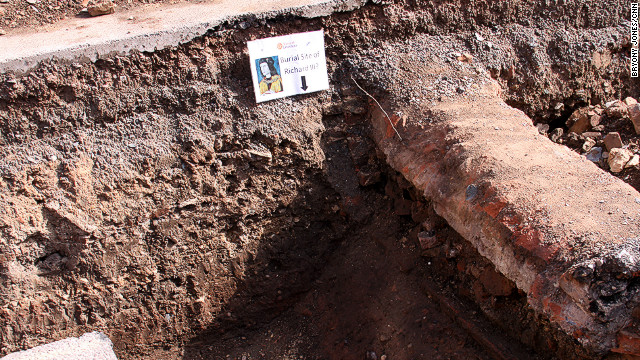
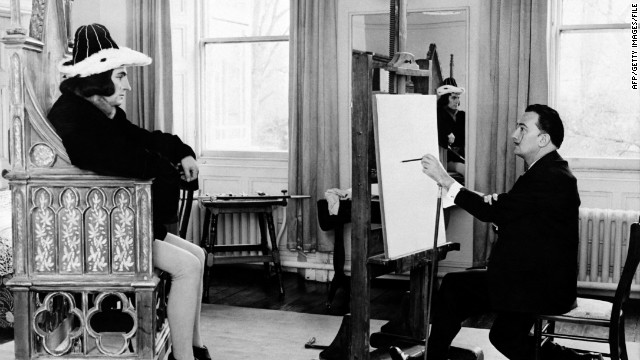
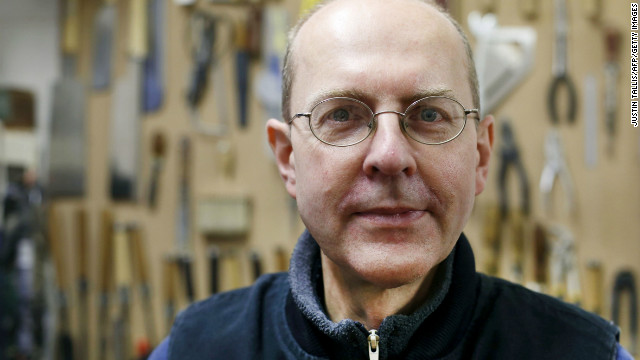
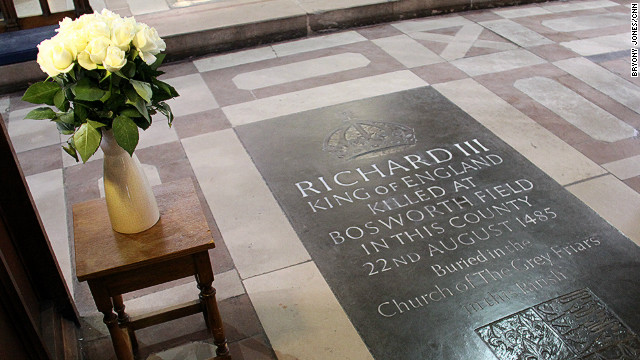
ไม่มีความคิดเห็น:
แสดงความคิดเห็น